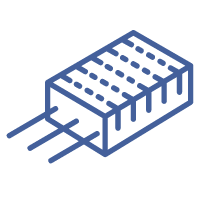
- Mounting TypeSurface Mount, MLCC
- Package / Case0805 (2012 Metric)
- PackageTape & Reel (TR)
- Base Product NumberVJ0805
- MfrVishay Vitramon
- Product StatusActive
- Voltage Rated
RATED voltage is the voltage on the nameplate - the "design point" for maximum power throughput and safe thermal operation.
250V - Operating Temperature
The operating temperature is the range of ambient temperature within which a power supply, or any other electrical equipment, operate in. This ranges from a minimum operating temperature, to a peak or maximum operating temperature, outside which, the power supply may fail.
-55°C ~ 125°C - SeriesVJ HIFREQ
- Size / Dimension0.079 L x 0.049 W (2.00mm x 1.25mm)
- Tolerance±0.25pF
- Temperature Coefficient
The resistance-change factor per degree Celsius of temperature change is called the temperature coefficient of resistance. This factor is represented by the Greek lower-case letter “alpha” (α). A positive coefficient for a material means that its resistance increases with an increase in temperature.
C0G, NP0 - ApplicationsRF, Microwave, High Frequency
- Capacitance2 pF
- Voltage - Supply4.4V ~ 5.5V
- Orientation-
- Termination StyleSMD (SMT) Tab
- Actuator TypeExternal Magnet, Not Included
- Output TypePWM
- Lead Spacing
the distance between two baselines of lines of type. The word 'leading' originates from the strips of lead hand-typesetters used to use to space out lines of text evenly. The word leading has stuck, but essentially it's a typographer's term for line spacing.
- - Lead Style-
- Built in SwitchNo
- Encoder Type
An encoder is classified into four types: mechanical, optical, magnetic, and electromagnetic induction types.
Magnetic - DetentNo
- Pulses per Revolution
Pulses per revolution (or PPR) is a parameter associated with encoders. Basically, it is a measure of the number of pulses per full revolution or turn of the encoder, with a full revolution being 360 degrees. In essence, it is a measure of an encoder's resolution.
- - Rotational Life (Cycles Min)-
- FeaturesHigh Q, Low Loss
- Height Seated (Max)-
- Thickness (Max)0.057 (1.45mm)
- Ratings-








